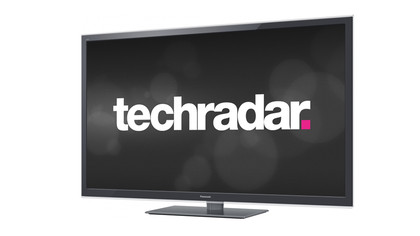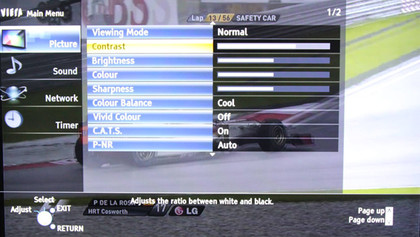Why you can trust TechRadar
Although we're chomping at the bit to try out the TX-L37ET5's Easy 3D system, it's immediately obvious that this TV has a well-made LED-backlit LCD panel at its heart; there's no light leakage from LED clusters at the extremities of the panel, though that's tempered by a quickly fading image if you watch from the wings. Contrast suffers particularly on a set that doesn't deliver inky tones even viewed from the centre, though black levels are the right side of acceptable.
A tight viewing angle aside, Freeview HD channels sparkle, with lots of vibrant colours and plenty of detail, but the latter takes a slight dive with our 2D Blu-ray test disc, The Rum Diary. As Kemp is egged-on by Chenault in a 'who screams first' contest, the speeding red Austin-Healey remains intact thanks not only to judicious braking, but also Intelligent Frame Creation, which we used on its lowest setting to banish blur and judder.

Sadly the whole scene - including close-ups - suffers from what looks like 'jaggies', poorly defined horizontal lines. It's down to the make-up of the polarising filter on the front of the TV - and it's much more of a problem on DVD and standard definition sources.
It's perhaps the same physical attribute that takes something away from SD channels; Empire on BBC One looks noisy and lined, in complete contrast to a HD broadcast, though DVDs and a clutch of DivX files are upscaled relatively cleanly.
To see how the TX-L37ET5 handles 3D we engaged IMAX favourite Legends of Flight on 3D Blu-ray. In a bright scene (though slightly dulled by the donning of the 3D specs) of a glider swooping past the Rocky Mountains it's obvious that this is a relatively soft 3D image. Not only is there noticeably less detail, but the horizontal lines of the picture are constantly visible.

We also spotted some double imaging, or crosstalk, both at the tips of the wings as they swing past close to the camera, and in some of the mountainous background, though it's only a seriously distracting problem on extreme foreground objects. It's an issue that gets more serious if you watch the image from anywhere else but dead centre.
Most importantly, the experience is never tiring, 3D depth effects are mostly impressive, and it's all a lot more versatile than active shutter; we watched Piranha in 3D with sun streaming in through windows without any problems.
We also put the TX-L37ET5 into 3D conversion mode, and the results with The Rum Diary were rather good. Slight, perhaps, but easy to watch with inconsistencies in depth effects less obvious than on active shutter 3DTVs. In one scene as Kemp and Sala walk around a palm-fringed crescent beach the various lines of trees are separated from each other and really do standout as 3D elements. It's a neat trick on a TV that struggles to impress us on any one aspect, but remains a great all-rounder.
Jamie is a freelance tech, travel and space journalist based in the UK. He’s been writing regularly for Techradar since it was launched in 2008 and also writes regularly for Forbes, The Telegraph, the South China Morning Post, Sky & Telescope and the Sky At Night magazine as well as other Future titles T3, Digital Camera World, All About Space and Space.com. He also edits two of his own websites, TravGear.com and WhenIsTheNextEclipse.com that reflect his obsession with travel gear and solar eclipse travel. He is the author of A Stargazing Program For Beginners (Springer, 2015),

